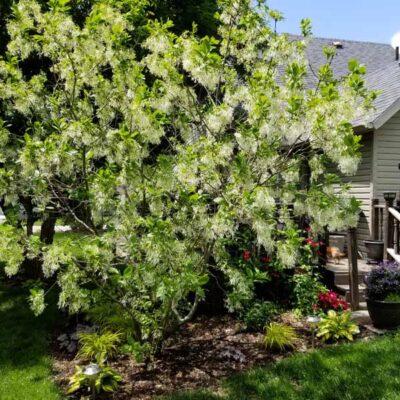Garden Plant: White Fringe Tree
Product Description: White Fringe Tree

Showy, Pretty Native White Fringe Tree
- Gorgeous Native Tree
- Unusual Spring Flowers
- Showy, Smaller Ornamental Tree
- Very Hardy and Easy Care
We aren’t sure why this gorgeous native tree isn’t better known. White Fringe Tree (Chionanthus virginicus, var. maritimus) is a knock out ornamental in an early spring garden. Fragrant white flowers featuring exquisite, fine-textured ribbon-like petals simply cover this small tree.
It might look delicate, but trust us, this native tree is adaptable over a wide range of growing hardiness zones. This is a great, non-fussy tree. They’ll even tolerate air pollution, and so make a good urban tree.
Be patient with it, as it’s often the last tree to leaf out in the spring. Trust us, it’s worth the wait because when it does leaf out, it simultaneously covers itself with these unusual white spring blooms.
They give the whole tree an appearance of being laced with elaborate white fringe, which is where it gets its name. You might hear some other common names, such as “Grancy Graybeard” or “Man Beard” tree.
This tree is actually related to the Olive family. The White Fringe Tree comes in both male and female plants. The pleasantly-fragrant flowers give over to clusters of small, olive-like fruits which are less than an inch long. They’ll ripen to a dark navy blue in late summer. Only the female flowers produce fruit drupes.
The ripening fruit is an event eagerly anticipated by local birds and wildlife. You might want to set a reminder to watch for them to develop. If you don’t, they’ll be eaten that quickly and You’ll miss the show.
Even the long, medium to dark green ovoid leaves are pretty. Because it’s a deciduous tree, it will drop the wide, spear shaped leaves in late autumn, but not until they’ve turned a golden-yellow. This tree makes an impact in your yard.
Order this beautiful native tree today!
How to Use White Fringe Tree in the Landscape
White Fringe Tree has a soft, sweet, open branching structure. You’ll want to give this tree a special spot in the landscape.
Plant it in small groups of three or four along a woodland border. They can be placed along a driveway, or near a pond.
These can also be spectacular used as a backdrop to a shrub border. If you allow their lower branches to grow, they’ll make great screening plants by early summer.
They’ll work under utility wires and are also great for use as a specimen in a lawn.
This is an interesting native tree that is well worth considering.


